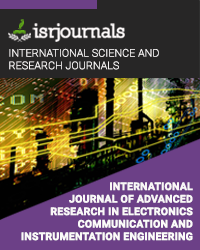security in mobile data offloading using steganography: diamond encoding
M.Vinoth Kumar,Anil Kumar Gona,Venneti Kiran
Published in International Journal of Advanced Research in Electronics, Communication & Instrumentation Engineering and Development
ISSN: 2347 -7210 Impact Factor:1.9 Volume:2 Issue:1 Year: 08 April,2014 Pages:19-18

Abstract
Mobile cloud offloading can save the energy consumption in the user mobile devices and PDAs. The mobile devices which has limited resources sends the heavier part of the program to a server in the cloud through network and the mobile device performs the lighter part of the program process. The server executes the program and sends the computed result to the mobile device, where both the results are combined and it is executed to the user. It is observed that offloading also reduces the response time of the device. Mobile data offloading, however involves security and privacy issues of the data being offloaded. To solve this problem we use Steganography methods to hide the data being offloaded out of the grid. Here the data is hidden in a cover image and it is transmitted as the resulting stego image. The server cannot read the hidden data, as we are not transmitting the cover image to the cloud. The existing method uses simple LSB substitution method to hide the data in the cover image, which provides PSNR values ranging from 32dB to 50dB and has fewer payloads. The proposed method introduces an efficient data hiding method called Diamond Encoding which results in higher PSNR values than the existing system and also provides larger payloads, that is more data can be hidden than the existing system.
Kewords
Mobile cloud computing, Mobile cloud offloading, Steganography, Peak Signal to Noise Ratio(PSNR)ABSTRACT
Reference
[1] Mazedur Rahman, Jerry Gao, and Wei-Tek Tsai, “Energy Saving in Mobile Cloud Computing,” 2013 IEEE International Conference on Cloud Engineering, Beijing, China, 978-0-7695-4945-3/13 © 2013 IEEE. [2] Karthik Kumar, Jibang Liu, Yung-Hsiang Lu, Bharat Bhargava, “A Survey of Computation Offloading for Mobile Systems”, © Springer Science+Business Media, LLC 2012. [3] Z. Sanaei, S. Abolfazli, A. Gani, and M. Shiraz, “Service-Based Arbitrated Multi-Tier Infrastructure for Mobile Cloud Computing,”IEEE Workshop on Mobile Cloud Computing, Beijing, China, 2012. [4] Karthik Kumar and Yung-Hsiang Lu, Purdue University, “Cloud Computing For Mobile Users: Can Offloading Computation Save Energy?” Published by the IEEE Computer Society 0018-9162/10/ APRIL2010©2010IEEE. [5] Ruey-Ming Chao, Hsien-ChuWu,Chih-Chiang Lee, and Yen-Ping Chu, “A Novel Image Data Hiding Scheme with Diamond Encoding”, EURASIP Journal on Information Security © 2009 Ruey-Ming Chao et al. [6] A. Berl, et al., "Energy-Efficient Cloud Computing," The Computer Journal, vol. 53 (7), pp. 1045–1051, 2009. [7] Kumar et al. Ranking Servers Based on Energy Savings for Computation O²oading. In ISLPED, pages 267{272, 2009. [8] M. Creeger, “CTO Roundtable: Cloud Computing,” ACM Queue, June 2009, pp. 1-2. [9] Jibang Liu, Karthik Kumar, and Yung-Hsiang Lu, “Tradeoff between Energy Savings and Privacy Protection in Computation Offloading” ISLPED’10, August 18–20, 2010, Austin, Texas, USA. Copyright 2010 ACM 978-1-4503-0146-6/10/08. [10] Li et al. Computation O²oading to Save Energy on Handheld Devices: a Partition Scheme. In CASES, pages 238{246, 2001.

